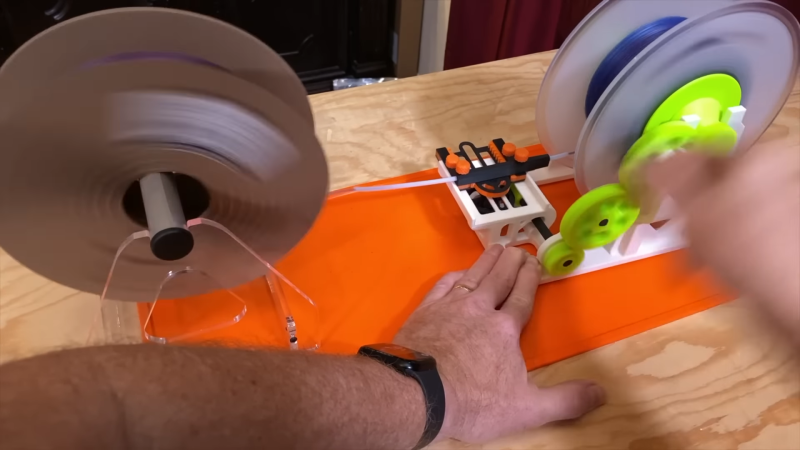No matter how far down the 3D printing rabbit hole we descend, chances are pretty good that most of us won’t ever need to move filament from one spool to another. But even so, you’ve got to respect this purely mechanical filament respooler design, and you may want to build one for yourself just because.
We were tipped off to [Miklos Kiszely]’s respooler via the very enthusiastic video below from [Bryan Vines] at the BV3D YouTube channel. He explains the need for transferring filament to another spool as stemming from the switch by some filament manufacturers to cardboard spools for environmental reasons. Sadly, these spools tend to shed fibrous debris that can clog mechanisms; transferring filament to a plastic spool can help mitigate that problem.
The engineering that [Miklos] put into his respooler design is pretty amazing. Bearings excepted, the whole thing is 3D printed. A transmission made of herringbone gears powers both the take-up spool and the filament guide, which moves the incoming filament across the width of the spool for even layers. The mechanism to do this is fascinating, consisting of a sector gear with racks on either side. The racks are alternately engaged by the sector gear, moving a PTFE filament guide tube back and forth to create even layers on the takeup spool. Genius!
Hats off to [Miklos] on this clever design, and for the extremely detailed instructions for printing and building one of your own. Even if you don’t have the cardboard problem, maybe this would help if you buy filament on really big spools and need to rewind for printing.
















One man’s plastic memorabilia is another man’s land fill place holder.
Interesting mechanism, I wonder could a modified, slower one shot, version be used to wind a high voltage tesla coil.
I was thinking well packed motor windings.
Like the fishing reels we used when we were kids – well, when some of us were kids.
Imagine how satisfied the guy who invented that half-gear rack and pinion setup must have been.
Nice mechanism.
However, if the intent is to avoid getting cardboard fibers on the filament, wouldn’t unwinding the filament at hundreds of times the usage speed just exacerbate the issue? And if the solution to that is to use a wiper before it enters the printer, could not that have been done in the first place?
If I understand correctly rewinding is done with powered rollers that the filament rolls sit on, at the bottom inside of the multi material unit. That part will always be open to dust from inside the machine and possible to have cardboard fingers collect. The real solution is just, regular cleaning / dusting. Spinning the spool like this isn’t an issue because any cardboard fibers being created that might cause issues are being done so on your countertops not inside your expensive multi material holder. Honestly I don’t really see this being like an urgent use, more like a long term possible chronic condition causer
Most of us using this have a Bambu AMS system, it has trouble winding cardboard spools when filament changes occur. I know mine does but has no problem with the hundreds of plastic spools I have that I refuse to allow to see the landfill. So I spend about an hour a day moving cardboard spooled filament to usable spools for my AMS system so I can have successful multicolor prints.
I respool rainbow style filaments when I need to reverse the order of the colors. RGB -> BGR
Neat.
I have respooled from a bulk filament holder, so was quite big onto a smaller proprietary spool and found the spool snapped into many pieces after a week or two. Apparently the new curve of the filament was too severe and it just cracked.
I tried double spooling it so the larger diameter filament was temporarily on the inside of the spool, but the reversed after the second respoolung. It was better.
Filament is originally spooled when it’s warm and significantly more flexible, so if you want to safely respool it you should warm it back up! Either beforehand to spool it when warm, or afterwards on the new spool to relieve the induced stresses that cause it to eventually fracture.
Regardless of one argues for one or other issue it is still a PHENOMENAL build. Congratulations 👏👏👏